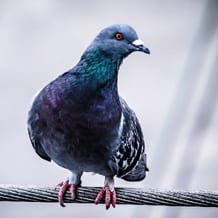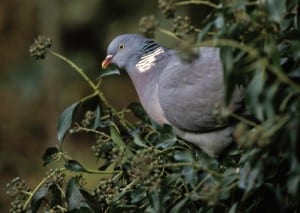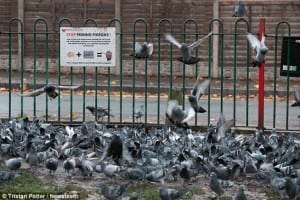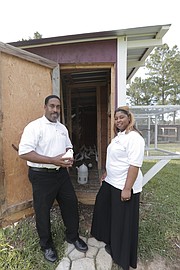
by Ryan Ponto | Sep 1, 2016 | Bird Netting
 OTTERVILLE — When Don Bryant was 11 years old in Belleville, while riding his bike home from school he saw a group of pigeons fly over his head, which led him to his mentor.
OTTERVILLE — When Don Bryant was 11 years old in Belleville, while riding his bike home from school he saw a group of pigeons fly over his head, which led him to his mentor.
Impulsively, he followed the birds to the home of Clarence Haymann, who as his mentor, started Bryant, now 83, with his first pair of pigeons.
After his first pigeon pair, he got another pair and started raising squabs, or baby pigeons, until he had six or seven pair. He spent time with people who raised and raced pigeons to find out how they did it, what to feed them and how to race them himself. His first loft was in the back of his parent’s chicken coop.
“It amazed me how pigeons could find their way home from hundreds of miles away,” marveled Bryant, who has had a cottage in Chautauqua for almost 50 years. “A combination of an extremely accurate internal ‘sun clock’ and magnetic fields enable the birds to return home.
“My best friend, Kenny Borsch, became interested in pigeons, too, and we started training young birds. We were too young to drive a car, so we wired boxes to our bicycles and rode three or four miles to let the birds out to fly home. After awhile, we talked Kenny’s grandfather into driving us 10 miles away to train our birds.”
Bryant built his first loft from lumber he got from a construction site where they were building a bridge.
“I talked the boss into giving me the lumber. They were going to throw it away and I built the loft myself,” he recalled.
Homing pigeons were introduced to the United States in the mid-1800s. In the 1880s, the first 500-mile race took place in this country. Homing pigeons race from 80 to 600 miles at speeds of 40 to 60 mph, over terrain they have often never seen before.
Pigeons have long played an important role in war. Due to their homing ability, speed and altitude, they were often used as military messengers. Carrier pigeons of the Racing Homer breed were used to carry messages in World War I, World War II and the Korean War. They ceased being used as of 1957. They saved thousands of lives while in military service.
Bryant loves long-distance flying. His pigeons fly 100 to 600 miles. When he was 13, he flew his pigeons in one of his first races, which was a 500-mile race. He should have won, but his lack of knowledge caused him to lose first place. He didn’t realize you needed to watch your loft to clock your bird in, the minute it returns to the loft.
He went to the movies instead and didn’t clock in his bird until the next morning. His bird was second, but would have won if he had clocked her in when she returned to the loft. He doesn’t remember the movie he saw, but he never forgot the valuable lesson he learned: stay by your loft.
“To raise money, I had to shine shoes, haul ashes and cut grass to support my pigeons,” Bryant said.
When Bryant enlisted in the U.S. Navy in 1951, he gave Kenny all his pigeons. When he came out of the Navy, he met and married his wife, Lynn Schleicher, and raised a family. He didn’t raise pigeons for a number of years.
He began his career in real estate in 1966. He didn’t raise or race pigeons while he was becoming one of the top Realtors in the Riverbend and building his own business — Don Bryant’s Gallery of Homes. He sold his business in 1983.
When he became interested in flying pigeons again, he went into it in a big way. He has four lofts in Otterville, with a partner, Tim Widowski. Two of the lofts are breeding lofts, one is a racing loft and the last loft is for his special birds. Their loft is named “Union Forest.”
The loft has two 15-year-old Houbens and two Stuart Browns. They are the foundation of Widowski and Bryant’s lofts. In all, Bryant and Widowski have more than 100 birds.
“Our birds are great. We carefully breed and train them in order to raise the best birds,” Bryant said.
There are two 10-week periods of racing every year. Old birds fly from April through June. The youngsters start racing in mid-August and fly until mid-October.
Bryant has been very successful in racing his pigeons. His pigeons have won in old-bird races in the last two years: Champion Bird Illinois twice, Champion Loft twice, Master Loft twice, Average Speed in 22 races and National Award 15th in the United States in 2014. The award Bryant is most proud of is that, in 2015, of his bird “Sissy Jane,” which placed second in the United States in the National Ace Old Bird Marathon Distance Standings.
Homing pigeons have pedigrees like racehorses. They are bred and trained with the same care bestowed upon their equine counterparts. Some international races award large cash prizes. Purses can be as high as $600,000. Racing pigeons have sold for more than $260,000 each.
“Being an American and my wife and family are the most important things in my life,” Bryant said.
Bryant and his wife have one son, Chuck Bryant, and two daughters, Donna Minard and Sally Voorhes. Bryant is still busy building and remodeling houses.
“At 83, it keeps me young,” Bryant declared.
About Pigeon Patrol:
Pigeon Patrol Products & Services is the leading manufacturer and distributor of bird deterrent (control) products in Canada. Pigeon Patrol products have solved pest bird problems in industrial, commercial, and residential settings since 2000, by using safe and humane bird deterrents with only bird and animal friendly solutions. At Pigeon Patrol, we manufacture and offer a variety of bird deterrents, ranging from Ultra-flex Bird Spikes with UV protection, Bird Netting, 4-S Gel and the best Ultrasonic and audible sound devices on the market today.
Voted Best Canadian wholesaler for Bird Deterrent products four years in a row.
Contact Info: 1- 877– 4– NO-BIRD (www.pigeonpatrol.ca)

by Ryan Ponto | Aug 31, 2016 | Bird Netting
It’s official: the hunting season is here again and in certain parts of the country a select few are out hunting bear and sheep and deer. The majority of us, however, are getting our first taste of the hunt with doves. I’m not a great dove hunter, although I’m not exactly to blame. During most of my lifetime, we didn’t even have a dove season in Minnesota. Fortunately, that changed some years back, and now every September 1 I get to head out in hopes of seeing a dove. I say “in hopes of” because dove numbers where I live are not great. You can find them and, on occasion, you can get a shot. But we still don’t have dove hunting in Minnesota like they do in other states.
There are places like Yuma, Arizona, where dove hunting is such a big deal that the local high schoolers hold a fundraiser in the form of a drive-thru dove cleaning station. For $5, the high school band will clean your limit of doves. And, when they are done, you can take your limit to any number of restaurants where they will cook up your birds for you. Just once in my life I would like to experience dove hunting on that level.
For now, however, I will just be happy to get out and see if I can shoot my two or three doves and hopefully get a small meal out of them. While I’m out there, I keep my eyes open for another bird: one that used to be a popular game bird, but that has caught such a bad reputation many people would never consider eating them.
Pigeons are all over the place here in farm country. They live in barns and silos and most farmers will let you come in a shoot a few. Pigeons are a little bigger than doves and equally tasty, in my opinion.
Like doves, pigeons can be prepared in a number of different ways. If you have enough pigeons, you can put together a really nice dinner. Juniper-roasted doves with a cherry port sauce is one of my favorite ways or you can make them just like doves into poppers with a little cream cheese, jalapeño, and bacon.
For these squabs, I am tweaking a Jamie Oliver recipe for a fried squab with a sweet and sour dipping sauce. The pigeons are rubbed with Chinese five spice and then fried whole. It doesn’t take long to fry a whole bird, and you end up with a very tender breast and crispy salty skin. Give pigeons a try, if you haven’t yet—you might be surprised at how good they are.
Spice Rub
2 tablespoon of kosher salt
2 teaspoons Chinese five spice
1 teaspoon black pepper
Small pinch of cayenne for heat
Combine the ingredients and rub it on the inside and outside of the squabs. Let sit out for 30 minutes before frying. Heat oil (I used peanut oil but just about any oil would work) over medium-high heat until oil reaches 350 degrees. Lower the squabs whole in the oil so they are completely submerged. Cook for 4-5 minutes—four if you want some pink in the middle of the breast and five if you don’t. Pull the birds out and set aside to drain and cool. While they pigeons are draining make your sauce.
Sweet and Sour Dipping Sauce
Juice of one lemon
Juice of one lime
¼ cup oyster sauce
2 tablespoons of Sriracha
1 tsp fresh grated ginger
1 clove of garlic minced
Combine all ingredients, mix well and serve with fried squabs.
About Pigeon Patrol:
Pigeon Patrol Products & Services is the leading manufacturer and distributor of bird deterrent (control) products in Canada. Pigeon Patrol products have solved pest bird problems in industrial, commercial, and residential settings since 2000, by using safe and humane bird deterrents with only bird and animal friendly solutions. At Pigeon Patrol, we manufacture and offer a variety of bird deterrents, ranging from Ultra-flex Bird Spikes with UV protection, Bird Netting, 4-S Gel and the best Ultrasonic and audible sound devices on the market today.
Voted Best Canadian wholesaler for Bird Deterrent products four years in a row.
Contact Info: 1- 877– 4– NO-BIRD (www.pigeonpatrol.ca)

by Ryan Ponto | Aug 30, 2016 | Bird Netting
 You’re on the edge of a riverbank, enjoying the view, the cool freshwater misting around you. Suddenly a monstrous catfish — 15 times your size — leaps out of the river, beaching in front of you. In one quick gulp, it sucks you down its gullet and then retreats back into the water.
You’re on the edge of a riverbank, enjoying the view, the cool freshwater misting around you. Suddenly a monstrous catfish — 15 times your size — leaps out of the river, beaching in front of you. In one quick gulp, it sucks you down its gullet and then retreats back into the water.
Fish belong in the water, right? What business do they have leaping out of their world and into ours? In this episode of Stuff to Blow Your Mind, Robert and Joe explore the surprisingly fascinating, dangerous and mysterious world of leaping, jumping and gliding fish. From skewering swordfish and breaching sharks to the alleged urethra-bound candiru, nature provides more than a few mind-blowing specimens of note.
Thankfully, you are not a mouse. If you were, this might be your fate along Australia’s Ashburton River. Scientists surveyed 18 lesser salmon catfish there and found large quantities of spinifex hopping mice in their guts. They published their findings in the Journal of Arid Environments. From other studies, we know that similar small mammals made up around 4 percent of this catfish’s diet. But this is the first report of these catfish devouring high levels of terrestrial mammals.
Both the lesser salmon catfish and the spinifex hopping mouse are common in northwestern Australia, but it was previously thought that this catfish species primarily ate insects, crustaceans and plants. But 44 percent of the 18 fish sampled had mice in their stomachs. Of those, the mice were about 95 percent of their stomach content. Two of the fish even had three mice each in their bellies. Catfish may be omnivorous, but snacking on mice is considered unusual. So how did they get there?
The researchers have two theories. The most likely is that heavy rains may have flooded the underground burrows of these mice, pushing them into the river. So rather than being gobbled up on the river’s edge, they drowned to death in their home and then the catfish had a fancy feast.
The other possibility is that these catfish are adapting, much like their larger cousins Silurus glanis. Researchers found that the larger catfish, displaced from their native habitat, were beaching themselves to eat pigeons, and 28 percent of the time they successfully captured one. Even more remarkable? They risked being stranded on the riverbank to do it. But the high-energy meal of a pigeon goes a long way when you’re a hungry catfish, so it must have been worthwhile. Maybe these lesser salmon catfish are making the same gambit in hopes of scarfing down some hopping mice?
Rest assured, catfish won’t be eating us humans anytime soon. But we still recommend that you avoid “noodling” in Australia. What’s noodling you ask? It’s when you wade into the water, feel around for a catfish hole, shove your hand in, wiggle your fingers around and wait for one to bite your hand. This type of fishing is mainly practiced in America, and it can be dangerous. Catfish are strong enough to pull a person underwater, especially if you’re wearing gloves that get caught on their teeth. They can also twist around and rip the flesh right off your bare hands.
But hey, at least we’re not being devoured off the side of a riverbank … or drowning underground before being picked apart by bloodthirsty catfish. In the meantime, human researchers hope to investigate this food cycle further, to make sure the local ecosystem hasn’t been thrown off-balance.
About Pigeon Patrol:
Pigeon Patrol Products & Services is the leading manufacturer and distributor of bird deterrent (control) products in Canada. Pigeon Patrol products have solved pest bird problems in industrial, commercial, and residential settings since 2000, by using safe and humane bird deterrents with only bird and animal friendly solutions. At Pigeon Patrol, we manufacture and offer a variety of bird deterrents, ranging from Ultra-flex Bird Spikes with UV protection, Bird Netting, 4-S Gel and the best Ultrasonic and audible sound devices on the market today.
Voted Best Canadian wholesaler for Bird Deterrent products four years in a row.
Contact Info: 1- 877– 4– NO-BIRD (www.pigeonpatrol.ca)

by Ryan Ponto | Aug 29, 2016 | Bird Netting
 PIGEONS droppings (pigeon poo) are “not” causing a nuisance to members of the public, according to Barrhead’s local authority.
PIGEONS droppings (pigeon poo) are “not” causing a nuisance to members of the public, according to Barrhead’s local authority.
East Renfrewshire Council (ERC) has responded to calls from members of the public and a local councillor for more anti-pigeon measures at Barrhead Train Station.
Commuters claimed that the ground around the station was slick with pigeon poo – and that they often ran under the bridge for fear of “raining poo”.
The council claims that it had plans to instal pigeon proof netting at the bridge last year – but essential works to the bridge paid heed to the plans.
However ERC now says that while it does not deem the birds to currently be a nuisance, it will be taking precautionary measures to prevent the bridge’s pigeon populations from booming.
A spokeswoman for ERC said: “East Renfrewshire Council had plans in place to install netting to the Barrhead rail bridge in April last year however due to essential repairs having to be carried out by Network rail, the installation had to be delayed.
“Our Environmental Health team have been monitoring the rail bridge since the essential works have taken place and do not deem there to be any level of nuisance from the pigeons currently or health risk to the public.
“This however could deteriorate should more birds appear, so as a precautionary measure proofing work will be carried out.
“A suitable contractor will carry out the installation of netting in mid-October 2016.”
Network Rail recently completed a £1 million overhaul of the 1900s structure on Paisley Road, forcing months of road delays.
During the renovation the bridge’s resident pigeon population was shifted.
Independent councillor Danny Devlin previously said: “They are leaving an awful mess and it’s just disgusting.
“I have received plenty of complaints from my constituents about the constant barrage that they have to endure when they risk walking under that bridge at any time of the day.
A quick reconnaissance of the street reveals slick patches of pigeon poo on the pavement below, and as well as a hygiene hazard it is claimed that the dung also represent a fall hazard.
About Pigeon Patrol:
Pigeon Patrol Products & Services is the leading manufacturer and distributor of bird deterrent (control) products in Canada. Pigeon Patrol products have solved pest bird problems in industrial, commercial, and residential settings since 2000, by using safe and humane bird deterrents with only bird and animal friendly solutions. At Pigeon Patrol, we manufacture and offer a variety of bird deterrents, ranging from Ultra-flex Bird Spikes with UV protection, Bird Netting, 4-S Gel and the best Ultrasonic and audible sound devices on the market today.
Voted Best Canadian wholesaler for Bird Deterrent products four years in a row.
Contact Info: 1- 877– 4– NO-BIRD (www.pigeonpatrol.ca)

by Ryan Ponto | Aug 28, 2016 | Bird Netting
 A couple has just said heart-wrenching vows and exchanged rings. After walking down the aisle together, they step outside for one more wedding ritual. As the wedding party counts down from five and the couple look to the skies, two white doves took flight out of a small cage and soar into the clouds.
A couple has just said heart-wrenching vows and exchanged rings. After walking down the aisle together, they step outside for one more wedding ritual. As the wedding party counts down from five and the couple look to the skies, two white doves took flight out of a small cage and soar into the clouds.
#Terrence and Rotoniya Kendrick, Mississippi natives and owners of Perfect Flight White Dove Releases, have started giving events a special touch. Perfect Flight began in Farmhaven, Miss., which is about 10.5 miles northeast of Canton, in July 2014. The couple started out raising chickens, but a neighbor, Albert Brown, later introduced them to pigeons. Brown showed them how to train and care for the birds, which later motivated the Kendricks to start their dove-releasing business.
#”(Brown) made me look at it from a fun perspective,” Terrence says.
#Terrence says he has loved birds since he was a kid.
#”We’ve had all kinds of birds-—parakeets, ducks, turkeys and guineas, which are a type of fowl,” he says.
#His passion for managing his own business and building something from the ground up now is in full flight. The Kendricks have a total of 70 pigeons with 20 new birds arriving soon. Their goal is to reach 100 birds by the end of September.
#The average number of doves released is three, with four for funerals and two for weddings. The most doves they have released at once was nine.
#Although the Kendricks often work ceremonials events like weddings and funerals, they are not limited to any specific type of affair. They can release doves at varied events such as birthdays, 5Ks and
memorials.
#The Kendricks have a precise way of pampering and training their nest of feathered friends. The monthly upkeep consists of deworming and medicating each pigeon for salmonella and other diseases. To keep them clean, the Kendricks simply set a pan of water out, and the pigeons dive in for a nice bird bath.
#”It’s important to keep a routine regiment to keep your birds healthy because they often come in contact with many other birds in flight,”
Terrence says.
#Training for the birds starts while they are young. They are kept locked away for a certain amount of time, and the Kendricks only let them out when it’s feeding time.
#The more the birds fly out, the more they will get used to their environment, which makes it easier for them to find their way home. Terrence also has whistles that trigger them to fly back home.
#Although they take flight often, they sometimes become skittish. The Kendricks get a laugh at the pigeons unexpectedly becoming slightly fearful of flying out and deciding that they do not want to fly on cue.
#Pigeons have a great sense of direction and know when and where to come back, Terrence says.
#”It’s a God-given instinct that they have, that scientists have yet to figure out,” Terrence says.
#As with many jobs, the couple’s field of work has an unpleasant side. Often, when the pigeons are released at some events, they do not return on the same day. Luckily for the Kendricks, the pigeons legs now have bands, which have numbers in case the birds are found. In other cases, some pigeons fall prey to larger birds, but Terrence says that if you keep the pigeons healthy, they’ll find a way home.
#The Kendricks tell a story about a woman who was a paraplegic who made plans to have doves released at her funeral.
#However, instead of waiting until her funeral, she had the birds released outside of her home for both her and her daughter to enjoy.
#”The best part about our job is seeing smiles and the joy on people’s face as they watch the doves fly,” Rotoniya says.
#When they are not releasing birds, the Kendricks tend to their eight acres of land, organizing their garden or raising their chickens, something they consider everyday life.
About Pigeon Patrol:
Pigeon Patrol Products & Services is the leading manufacturer and distributor of bird deterrent (control) products in Canada. Pigeon Patrol products have solved pest bird problems in industrial, commercial, and residential settings since 2000, by using safe and humane bird deterrents with only bird and animal friendly solutions. At Pigeon Patrol, we manufacture and offer a variety of bird deterrents, ranging from Ultra-flex Bird Spikes with UV protection, Bird Netting, 4-S Gel and the best Ultrasonic and audible sound devices on the market today.
Voted Best Canadian wholesaler for Bird Deterrent products four years in a row.
Contact Info: 1- 877– 4– NO-BIRD (www.pigeonpatrol.ca)

 OTTERVILLE — When Don Bryant was 11 years old in Belleville, while riding his bike home from school he saw a group of pigeons fly over his head, which led him to his mentor.
OTTERVILLE — When Don Bryant was 11 years old in Belleville, while riding his bike home from school he saw a group of pigeons fly over his head, which led him to his mentor.





 You’re on the edge of a riverbank, enjoying the view, the cool freshwater misting around you. Suddenly a monstrous catfish — 15 times your size — leaps out of the river, beaching in front of you. In one quick gulp, it sucks you down its gullet and then retreats back into the water.
You’re on the edge of a riverbank, enjoying the view, the cool freshwater misting around you. Suddenly a monstrous catfish — 15 times your size — leaps out of the river, beaching in front of you. In one quick gulp, it sucks you down its gullet and then retreats back into the water.
 PIGEONS droppings (pigeon poo) are “not” causing a nuisance to members of the public, according to Barrhead’s local authority.
PIGEONS droppings (pigeon poo) are “not” causing a nuisance to members of the public, according to Barrhead’s local authority.
 A couple has just said heart-wrenching vows and exchanged rings. After walking down the aisle together, they step outside for one more wedding ritual. As the wedding party counts down from five and the couple look to the skies, two white doves took flight out of a small cage and soar into the clouds.
A couple has just said heart-wrenching vows and exchanged rings. After walking down the aisle together, they step outside for one more wedding ritual. As the wedding party counts down from five and the couple look to the skies, two white doves took flight out of a small cage and soar into the clouds.